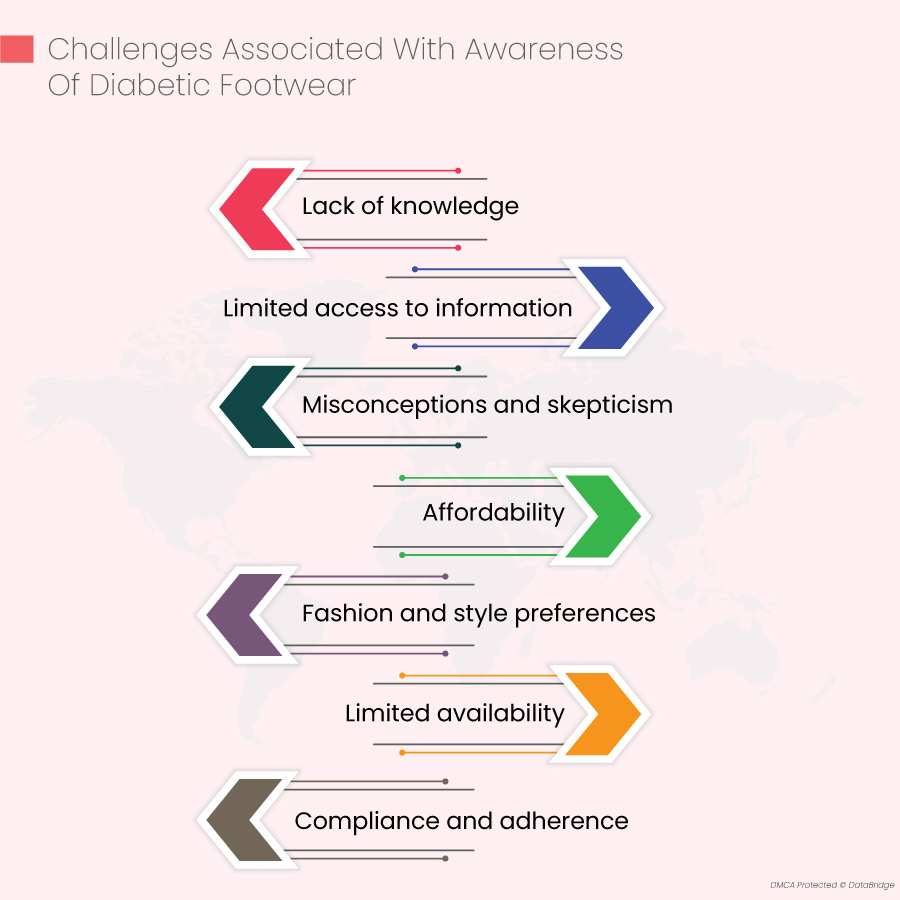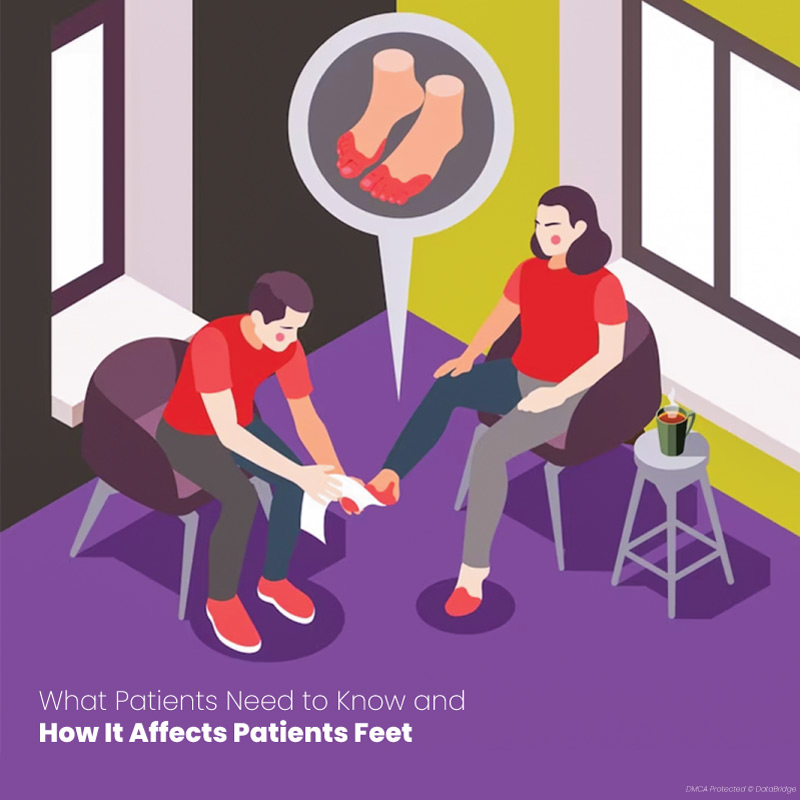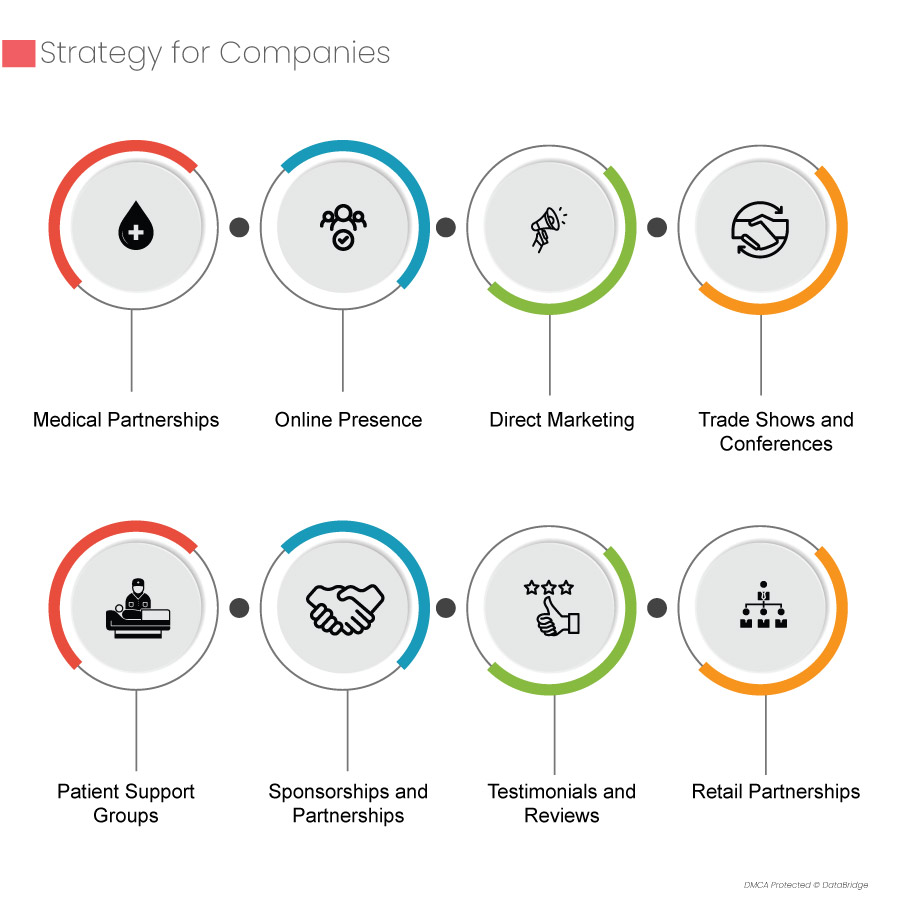Overview
The nerves and blood arteries that travel to the foot might be harmed by poorly managed blood sugar. People with diabetes are more likely to experience foot issues as a result. Wearing footwear with a specific design can assist lower risk and increase healthy circulation in patients' feet.
The market for diabetic shoes is being driven by several major factors, including the aging of the population, the rise in the number of women with diabetes around the world, improvements in online retail penetration, an increase in per capita income, and an increase in spending on diabetes treatment. Additionally, the rise in e-commerce, brand expansion in diabetic footwear, research, and development activities, technological advancements, and modernization of production methods will all cater new opportunities for the diabetic shoe market in upcoming years.
Diabetes is one of the main reasons for non-traumatic lower-limb amputations and increases the incidence of foot ulcers in diabetics.
In the present time, choosing the right footwear is crucial for managing diabetes. Pressure points that rub against the inside of shoes can be brought on by deformities such as hammertoes and bunions. Calluses and ulcers can develop due to wearing shoes that don't fit properly.
What are Diabetic Shoes?

Diabetes-related foot ulcers are prevented by wearing diabetic shoes, which lowers the need for amputations. They minimize pressure spots on the feet while offering protection and support. Additionally, they are deeper to accommodate diabetic inserts. The shoes come in various designs and are customized per the patient's requirements.
Amputation is a danger that people with diabetes are all too familiar with. Due to nerve degeneration and peripheral artery disease (PAD), many diabetic report diminished feeling and constrained blood flow in their feet. Infections and ulcers brought on by these two problems might result in amputations.
World Wide Diabetic Patient Scenario

As per the American Diabetic Association and The American Journal of Managed Care, it is estimated that diabetes is directly responsible for 60% of lower-leg amputations in patients 20 years of age and older.
The International Diabetes Federation estimates that 463 million adults worldwide, or one in every eleven, have diabetes. The numbers are predicted to increase by 2045; 700 million people will live with diabetes worldwide. Currently, the condition affects 60 million people in the European Union, or 8% of the total population. Around 40 to 60 million people worldwide have diabetes-related foot and lower limb problems, which are a significant causes of morbidity in diabetics. Chronic ulcers and amputations significantly reduce the quality of life for diabetics. According to expert medical assessments, wearing the wrong shoes is the primary reason for DFS difficulties. In fact, 80% of these issues are brought on by improper footwear.
Nowadays, diabetes is a common problem around the globe. As per the data published by Wisevoter of top 100 Countries of Diabetes Prevalence in 2022 is mentioned below. This data will assist diabetes shoes manufacturer in identifying the market potential of diabetic footwear in the following countries.
Top 100 Country Diabetes Prevalence
|
S.No
|
Country Name
|
Diabetes Rates
|
|
1
|
Pakistan
|
30.80%
|
|
2
|
Kuwait
|
24.90%
|
|
3
|
Nauru
|
23.40%
|
|
4
|
New Caledonia
|
23.40%
|
|
5
|
Northern Mariana Islands
|
23.40%
|
|
6
|
Marshall Islands
|
23.00%
|
|
7
|
Mauritius
|
22.60%
|
|
8
|
Egypt
|
20.90%
|
|
9
|
Solomon Islands
|
19.80%
|
|
10
|
Qatar
|
19.50%
|
|
11
|
Guam
|
19.10%
|
|
12
|
Malaysia
|
19.00%
|
|
13
|
Sudan
|
18.90%
|
|
14
|
Saudi Arabia
|
18.70%
|
|
15
|
Fiji
|
17.70%
|
|
16
|
Palau
|
17.00%
|
|
17
|
Mexico
|
16.90%
|
|
18
|
Papua New Guinea
|
16.70%
|
|
19
|
United Arab Emirates
|
16.40%
|
|
20
|
Saint Kitts and Nevis
|
16.10%
|
|
21
|
Federated States of Micronesia
|
15.60%
|
|
22
|
Vanuatu
|
15.60%
|
|
23
|
Jordan
|
15.40%
|
|
24
|
Syria
|
14.90%
|
|
25
|
Belize
|
14.50%
|
|
26
|
Turkey
|
14.50%
|
|
27
|
Bangladesh
|
14.20%
|
|
28
|
Barbados
|
14.00%
|
|
29
|
Oman
|
13.80%
|
|
30
|
Puerto Rico
|
13.30%
|
|
31
|
Guatemala
|
13.10%
|
|
32
|
Bermuda
|
13.00%
|
|
33
|
Cayman Islands
|
13.00%
|
|
34
|
Suriname
|
12.70%
|
|
35
|
Trinidad and Tobago
|
12.70%
|
|
36
|
Grenada
|
12.60%
|
|
37
|
United States Virgin Islands
|
12.40%
|
|
38
|
Tanzania
|
12.30%
|
|
39
|
Zambia
|
11.90%
|
|
40
|
Antigua and Barbuda
|
11.70%
|
|
41
|
Comoros
|
11.70%
|
|
42
|
Curaçao
|
11.70%
|
|
43
|
Dominica
|
11.70%
|
|
44
|
Guyana
|
11.70%
|
|
45
|
Saint Lucia
|
11.70%
|
|
46
|
Singapore
|
11.60%
|
|
47
|
Bahrain
|
11.30%
|
|
48
|
Sri Lanka
|
11.30%
|
|
49
|
Brunei
|
11.10%
|
|
50
|
Jamaica
|
11.10%
|
|
51
|
Afghanistan
|
10.90%
|
|
52
|
Chile
|
10.80%
|
|
53
|
South Africa
|
10.80%
|
|
54
|
Iraq
|
10.70%
|
|
55
|
United States of America
|
10.70%
|
|
56
|
Indonesia
|
10.60%
|
|
57
|
People's Republic of China
|
10.60%
|
|
58
|
Dominican Republic
|
10.50%
|
|
59
|
Bhutan
|
10.40%
|
|
60
|
Spain
|
10.30%
|
|
61
|
Albania
|
10.20%
|
|
62
|
Andorra
|
9.70%
|
|
63
|
Thailand
|
9.70%
|
|
64
|
India
|
9.60%
|
|
65
|
Tunisia
|
9.60%
|
|
66
|
Venezuela
|
9.60%
|
|
67
|
Nicaragua
|
9.30%
|
|
68
|
Maldives
|
9.20%
|
|
69
|
Palestine
|
9.20%
|
|
70
|
Bosnia and Herzegovina
|
9.10%
|
|
71
|
Iran
|
9.10%
|
|
72
|
Montenegro
|
9.10%
|
|
73
|
Morocco
|
9.10%
|
|
74
|
Portugal
|
9.10%
|
|
75
|
Serbia
|
9.10%
|
|
76
|
Uruguay
|
9.00%
|
|
77
|
Haiti
|
8.90%
|
|
78
|
Brazil
|
8.80%
|
|
79
|
Costa Rica
|
8.80%
|
|
80
|
The Bahamas
|
8.80%
|
|
81
|
British Virgin Islands
|
8.70%
|
|
82
|
Libya
|
8.70%
|
|
83
|
Nepal
|
8.70%
|
|
84
|
Cyprus
|
8.60%
|
|
85
|
East Timor
|
8.60%
|
|
86
|
North Korea
|
8.60%
|
|
87
|
Israel
|
8.50%
|
|
88
|
Seychelles
|
8.50%
|
|
89
|
Colombia
|
8.30%
|
|
90
|
Panama
|
8.20%
|
|
91
|
Lebanon
|
8.00%
|
|
92
|
Malta
|
8.00%
|
|
93
|
Saint Vincent and the Grenadines
|
8.00%
|
|
94
|
Hong Kong
|
7.80%
|
|
95
|
Macau
|
7.80%
|
|
96
|
Canada
|
7.70%
|
|
97
|
Cuba
|
7.60%
|
|
98
|
Paraguay
|
7.50%
|
|
99
|
Bulgaria
|
7.40%
|
|
100
|
Djibouti
|
7.40%
|
Source:- wisevoter
Diabetes is a worldwide health issue that is becoming worse. According to the World Health Organization, there will be more than 334 million diabetics worldwide in 2030. The main issues that people with diabetes face nowadays are brought on by the complications that the disease causes.
The term diabetic foot refers to one of the most critical problems. These people experience peripheral neuropathy, which causes them to lose feeling in their extremities, making them oblivious to foot sores until the lesion becomes septic. The infection then frequently resists healing due to further diabetes-related problems, ultimately resulting in the foot amputation. Adults with neuropathic diabetes are assumed to have abnormally high plantar pressures as a result of their neuropathy as the primary cause of foot ulcers.
Challenges Associated With Awareness of Diabetic Footwear

- Lack of knowledge:- Many diabetic patients are less aware of the difficulties they could encounter with their feet or how crucial it is to wear the right shoes. A lack of understanding may hamper the adoption of diabetic footwear and preventative measures.
- Limited access to information:- Some diabetic individuals might not have easy access to resources for treatment, such as details on specialized footwear. This may be because of various factors, including geography, social level, and linguistic obstacles. It's crucial to ensure everyone who could benefit from knowing about diabetic footwear receives it.
- Misconceptions and skepticism:- Diabetic footwear sometimes receives misunderstandings or skepticism. Some individuals could view it as superfluous or believe that conventional shoes suffice. It's crucial to dispel these myths and inform them of the precise characteristics and advantages of diabetic footwear.
- Affordability:- For diabetic people, acquiring specialized footwear can be a considerable obstacle. Since diabetic footwear is frequently more expensive than conventional footwear, not everyone may be able to afford it. It may be possible to overcome this difficulty by addressing affordability issues through insurance coverage, financial assistance, or partnerships with healthcare providers.
- Fashion and style preferences:- Some diabetic patients might be hesitant to wear diabetic footwear because they are worried about how it will look or whether it will go with their wardrobe. Diabetic footwear can be more widely accepted and used if these worries are eased by providing a range of patterns and styles that satisfy varied tastes.
- Limited availability:- Diabetic footwear are not easily available, particularly in outlying or underserved areas. This scarcity can make it difficult for diabetic individuals to obtain the proper footwear. Accessibility can be increased by widening distribution channels and working with retailers and healthcare organizations.
- Compliance and adherence:- Even when people are aware of the advantages of diabetic shoes, sustaining regular use might be difficult. Regularly using specialized shoes may be painful or bothersome for some patients. Healthcare practitioners can help to encourage compliance and adherence to wearing diabetic footwear by providing ongoing education, reinforcement, and support. Furthermore, various strategy such as education, awareness campaigns, accessibility upgrades, cost-effective solutions, and collaboration with medical specialists and diabetes management organizations is needed to overcome these obstacles.
Diabetes is one of the leading causes of death in poor nations. In 2019 estimated 63.8 million people in India people had diabetes, and by 2030, that number is expected to rise to 109 million. Due to the difficulties linked with diabetes, mortality and morbidity rates are incredibly high in India. The foot-related problem is one of the most important ones. A lower limb is thought to be lost somewhere in the world every 30 seconds as a result of diabetes, and the lifetime chance of having a foot ulcer for someone with diabetes could be as high as 25%. About 80–85% of those who have diabetic foot ulcers require lower-extremity amputations.
What Patients Need to Know and How it Affects Their Feet?

It's crucial first to comprehend that diabetes is a disorder in which a patient's body has trouble processing sugar. This can cause various health problems, including injury to patients' feet, elevated blood sugar levels, and other issues. This is because having high blood sugar can harm patients' feet's nerves, making them less responsive to pain and changes in temperature. Additionally, it might result in impaired circulation, which hinders the healing of cuts and blisters. This entails keeping them clean and dry and routinely inspecting them for any indications of damage or illness. Additionally, it involves selecting footwear with consideration. Avoid wearing tight shoes since they restrict blood flow and put additional pressure on patients' feet.
Peripheral Neuropathy
Neuropathy, or a loss of feeling, is one of the most serious ways diabetes can damage patients' feet. Due to the difficulty in determining whether the patient's shoes are properly fitting and generating any friction or blisters, more severe symptoms may result. The patient's feet may also become hypersensitive as a result of neuropathy, intensifying any rubbing pain. When managing diabetes, it's essential to pay attention to how the patient's shoes fit to avoid any issues.
To know more about the diabetic retinopathy treatment research study in terms of qualitative and quantitative research on present scenarios, future trends, factors driving the market consumption in upcoming years, industry challenges, and market growth potential for diabetic retinopathy treatment in the market kindly visit the link below.
https://www.databridgemarketresearch.com/reports/global-diabetic-retinopathy-treatment-market
- Why Fitting is the Most Important Thing for Diabetes
Because patients have a higher risk of developing foot-related issues if patients have diabetes, the fit of shoes is crucial. The nerves in the patient's feet may not function properly due to a poor blood supply, making it difficult for wounds, sores, or friction-related injuries caused by the patient's footwear to heal. Patients might not even be aware that they have occurred.
A loss of surface skin, sores, and foot ulcers can develop due to any type of damage, alteration to the skin, or change in the shape of the foot. For those who suffer from neuropathy, it may be difficult to tell whether the patient's shoes are bothersome or damaging. When purchasing footwear for diabetes, patients should always seek professional assistance as there are numerous considerations to take into account.
Why Diabetic Footwear?

Specialized shoes are available in the market for different purposes, even though many people might not know this. Baseball players don't wear tennis shoes, basketball players don't wear running shoes, and weightlifters don't wear shoes designed for joggers. For specific personalities and activities, there exist particular shoes. Shoes for people with diabetes are no different. Diabetes-specific footwear is made to shield the feet from stresses that could weaken the skin and lead to ulcers and sores that could be life-threatening. While purchasing diabetic shoes, one should concern the doctor and discuss which type of diabetic shoes they should buy as per the present scenarios.
Due to neuropathy and poor circulation, which impair the nerves' capacity to repair and detect any injury to the feet, diabetic patients are particularly at risk for foot wounds. As a result, problems go unnoticed and untreated since they are not felt. Sores may develop into ulcers and wounds without the person even realizing it. These wounds can then develop into serious, potentially fatal situations, including amputation.
A good diabetic shoe offers comfort, but its primary function is to protect. Diabetes-related footwear avoids the development of foot calluses and stress. To prevent irritation from materials rubbing against the foot, the interior is made of soft, seam-free materials with no stitching. When considering abnormalities like bunions or hammertoes, diabetic shoes have a roomy toe-box to allow extra room for the toes. Additionally, they frequently feature adds depth to accept bespoke orthotic inserts, which offer even more support and weight distribution away from pain spots.
Diabetic Footwear Benefit

- Reduced Risk of Foot Ulcers: - The purpose of diabetic footwear is to give the feet a cozy and safe environment. They have characteristics that reduce pressure, friction, and irritability, such as additional depth, large toe boxes, and smooth interiors. Diabetic footwear assists in preventing the emergence of foot ulcers, which can be a major problem for those with diabetes, by lowering these risks.
- Improved Foot Circulation:- Diabetes may impede the flow of blood to the feet and other extremities. Shoes for diabetics are frequently made of materials that encourage optimum air circulation, cushioning, and stress absorption. Enhancing blood flow to the feet can improve overall foot health and lower the risk of issues brought on by insufficient blood flow.
- Protection Against Foot Injuries:- Diabetes can damage the nerves (cause neuropathy), which makes it harder to feel pain or notice injuries. Due to their cushioning, supportive design, and proper fit, diabetic shoes offer additional protection. Common foot injuries like blisters, scrapes, and abrasions that could go unnoticed and possibly worsen can be avoided with the use of this protection.
- Accommodation for Foot Deformities and Orthotics:- Many diabetic patients may have foot abnormalities or need specialized orthotic inserts to treat particular foot issues. Shoes for diabetics often have more depth and room to handle these abnormalities and orthotics properly. It enables people to maintain normal foot alignment, lessen pain, and improve general mobility by offering a good fit and support.
- Enhanced Comfort and Mobility:- Comfort and easing foot pain are top priorities in the design of diabetic footwear. Their cushioning, supple fabrics, and non-binding attributes reduce pain spots and make walking more bearable. People are urged to be active, which is crucial for treating diabetes and preserving general health, by boosting mobility and easing discomfort.
- Prevention of Infections:- Diabetes can weaken the immune system, increasing a person's susceptibility to infections. Shoes for diabetics are frequently composed of breathable fabrics that wick moisture away, lowering the risk of fungus infections. These shoes' smooth interiors and perfect fit also reduce the possibility of skin irritation and the development of sores, which can lead to an infection.
While diabetic footwear has several advantages, it's vital to remember that good foot hygiene and regular monitoring are still essential. Diabetic patients should speak with their medical experts or a licensed pedorthist for the best advice and recommendations based on their individual foot health requirements.
Increasing Participation by the Companies to Create Awareness
In the present time, most of the companies are participating in creating awareness in the market. They provide two offering one is consulting services, and the second is offering diabetes footwear. In the consulting services, firstly company diagnoses the exact foot condition of the patient and, after that, recommends the best diabetes footwear as per the patient's conditions. In the second service, companies offer various types of diabetes footwear where the patient can select the footwear as per the recommendation received.
For Instance:-
- For people with diabetes, Elio's team of specialists offers support in order to help prevent foot issues. Elio's offers customized therapies for each patient based on their needs and financial situation, including diabetic foot care. Schedule an introductory consultation with a chiropodist to take the first step.
Elio's Foot Comfort Centre has started the following list of services, especially for diabetes patients.
- Self-management counseling
- Chiropody services on request
- Diabetic Shoes
- Diabetic House Shoes
- Custom Diabetic Orthotics
- Diabetic foot care
- Diabetic Insoles
- Compression socks
- Custom Footwear
- To minimize diabetic foot ulcers and avoid lower limb amputations in high-risk patients, the Medicare Therapeutic Shoe Bill was introduced. It enables individuals with diabetic problems to access extra-deep shoes and insoles.
- In 2020, Erasmus+ DiaSHOE launched a project to create more awareness among people suffering from diabetic disease. The project's primary goals are prevention and skill development, and it aims to assist shoe retailers, patients, healthcare professionals, and shoe manufacturers in addressing this issue. In the project, they have provided three different types of Digital Education Package respectively, which primary task was targeting, footwear technicians and product managers, Diabetic Foot Control designers, shoe shop employees, health technicians and patients, patient's families, informal caregivers, as well as school teachers and educators.
- DFC India (DIABETIC FOOT CLINIC) started a clinic focusing on providing the best service to diabetic patients. In the clinic, they deal with several types of diabetic patients and provide solutions.
- Orthofeet Company has designed special footwear for diabetic patients. This company designs diabetic footwear for both men and women. Orthofeet Company made the shoe with the best raw material, providing comfort during any activity.
To know about the diabetic socks research study in terms of qualitative and quantitative research on present scenarios, future trends, factors driving the market consumption in upcoming years, Industry challenges, and market growth potential for diabetic socks in the market.
Kindly visit the below-mentioned link, https://www.databridgemarketresearch.com/reports/global-diabetic-socks-market
Significant Strategies to Reach the Various Diabetic Patients

- Medical partnerships:- Establish referral programs in conjunction with medical specialists, including podiatrists and diabetic clinics. These collaborations may aid in spreading knowledge about the company's diabetic-friendly footwear solutions among medical professionals. Then, doctors can suggest these shoes to their diabetic patients.
- Online presence:- Create an extensive online presence using social media and a website. Make educational information for diabetes patients regarding proper foot care, the value of wearing the right shoes, and the company's diabetic-specific products. This can include articles, blog entries, and videos that provide insightful advice and information.
- Direct marketing:- To reach diabetes patients, use specialized marketing strategies such as direct mail and campaigns. Create marketing collateral emphasizing the advantages of diabetic shoes and highlighting how they can assist in controlling diabetes-related foot issues.
- Trade shows and conferences:- Engage in diabetes, podiatry, or general health and wellness-related conferences, trade events, and exhibitions. These occasions offer chances to show off the business's goods in front of doctors and patients.
- Patient support groups:- Participate in online networks or organizations for diabetic patients that are focused on managing the disease. Provide instructional materials, take part in debates, and teach people about the company's diabetic-friendly footwear options.
- Sponsorships and partnerships:- Join forces with charities, foundations, or organizations that deal with diabetes patients. The footwear manufacturer can raise its profile among people with diabetes and the medical experts who care for them by sponsoring events or collaborating with these organizations.
- Testimonials and reviews:- Encourage happy diabetic consumers to offer endorsements or evaluations of the brand's shoes. People with diabetes who have used the shoes and provided positive comments can help companies to draw in new clients.
- Retail partnerships:- Form alliances with businesses that cater to people with diabetes, such as diabetic supply shops, orthotic centers, or specialist shoe sellers. The footwear business may reach a larger audience of diabetes patients looking for suitable footwear solutions by making its products available at these places.
The diabetic shoe manufacturer needs to make sure that their products are suitable for diabetic patients, taking into account aspects like proper cushioning, support, and space for orthotics, as well as factors like breathability and ease of use for people with decreased foot sensitivity.
To know about the diabetic shoes market, visit https://www.databridgemarketresearch.com/reports/global-diabetic-shoes-market
In the full version of report Data Bridge Market Research will provide the market size in term of value (USD Million) and Volume (Million Units). This report on the diabetic shoe market will provide the details recent developments, trade laws, production analysis, value chain optimization, companies' market share, and the effects of domestic and regional market participants. It also examines opportunities for new revenue streams, regulatory changes, strategic market growth analysis, market size in term of value (USD Million) and Volume (Million Units), market expansions, application niches and dominance, product approvals, product launches, and geographic trends. Kindly contact with Data Bridge Market Research for an Analyst Brief to learn more about the diabetic shoe market. DBMR will assist you in making an informed choice to grow the market.
Technology Helps in Effectively Developing the Diabetic Footwear

By improving diabetic footwear design, functionality, and overall efficacy in treating diabetics' foot health, technology plays a vital role in developing diabetic footwear. Here are a few ways showcasing how technology influences the creation of diabetic footwear:
- Pressure Mapping:- Pressure-sensing devices and insole sensors that can assess the distribution of pressure on the feet can now be included thanks to technology. This information aids in developing footwear that lessens pressure points that are too great, which is essential for preventing diabetic patients' foot ulcers and other issues.
- Customization and 3D Printing:- Custom diabetic footwear can be made because of cutting-edge technologies like 3D scanning and printing. Precise measurements can be collected from a patient's feet using a scanner, and footwear can then be made to fit their unique foot size and form. The friction, pressure, and discomfort that might cause foot issues are lessened thanks to this customization.
- Smart Materials:- As a result of technological development, smart materials have been created that offer qualities that are advantageous for diabetic footwear. These materials have the ability to cushion, absorb shock, wick away moisture, and have antibacterial qualities. As an illustration, materials with moisture-wicking capabilities can assist in keeping the feet dry and lower the risk of infections.
- Temperature and Moisture Monitoring:- Diabetic shoes can have embedded sensors and microchips that measure the inside temperature and moisture content. It is possible for excessive heat and dampness to foster bacterial and fungal growth, which can result in illnesses. People can maintain adequate foot hygiene and avoid issues by monitoring these variables and taking preventative action.
- App Integration and Connectivity:- It is possible to create mobile applications that integrate with diabetic footwear. Real-time information on foot health, such as pressure distribution, temperature, and activity levels, can be obtained from these apps. Additionally, they can provide tools for instruction on foot care and serve as a reminder for routine foot exams. Thanks to app connectivity, individuals and healthcare professionals may easily track and manage foot health.
- Gait Analysis:- Gait analysis systems can be included using technology in diabetic footwear. These devices analyze a person's walking pattern using sensors and algorithms to find any imbalances or anomalies. The proper remedies, such as orthotic inserts or changes to the footwear, can be advised to improve foot mechanics and lower the risk of problems by recognizing gait difficulties.
The provision of useful information, customization possibilities, monitoring capacities, and interaction with other digital tools are just a few of the ways that technology promotes the development of diabetic footwear. These developments aim to better overall foot health management for diabetics by increasing comfort, preventing foot ulcers, lowering the risk of infections, and reducing infections.
What Sort of Diabetic Footwear Do Diabetic Patients Require?
If diabetes is well-managed and patients don't have any significant foot issues, a comfortable shoe that fits properly can be all patients need. But if patients do experience any foot issues, patients' doctor might suggest one of the following shoe choices:
- In-depth shoes:- Shoes with depth are between 1/4 and 1/2 inch deeper than regular shoes. The additional space helps tolerate changes in the foot, such as calluses or hammertoes. Deep shoes also provide space for inserts, should patients require them.
- Healing shoes:- Patients wear shoes while their feet heal from wounds or surgery. They are available as closed-toe or open-toe sandals. People with diabetes shouldn't wear open-toed shoes unless their doctor explicitly instructs them.
- Custom-made shoes:- A mold of the foot is used to make custom shoes. If patients have deformed feet, this shoe style might be a possibility for diabetic patients.
Therapeutic footwear is created expressly to maintain the health of patient's feet if any diabetic patients suffer from neuropathy, nerve damage, or an existing foot injury.
Orthopaedic footwear is intended to provide greater comfort for people who suffer from corns, bunions, or other foot issues. Diabetes is not a prerequisite for using orthopaedic footwear. Whatever shoe style or sole type patients like many orthopaedic shoe options are available.
Patients can customize shoes they already own in addition to buying new ones. For instance, patients may include a thicker, shock-absorbing sole. Orthotics are another option. These are footpads or inserts that go inside patient's shoes to relieve pressure and increase comfort for diabetic patient's feet.
Conclusion
Diabetes-related foot issues can be managed and prevented using diabetic footwear. These shoes are critical in preserving foot health and lowering the risk of the significant problems by offering pressure redistribution, accommodating orthotics, better comfort, and moisture management. Patients should get advice from a healthcare provider while choosing diabetic footwear and consider aspects including size, fit, cushioning, and breathability. People with diabetes can proactively protect their foot health and general well-being by investing in suitable footwear.







